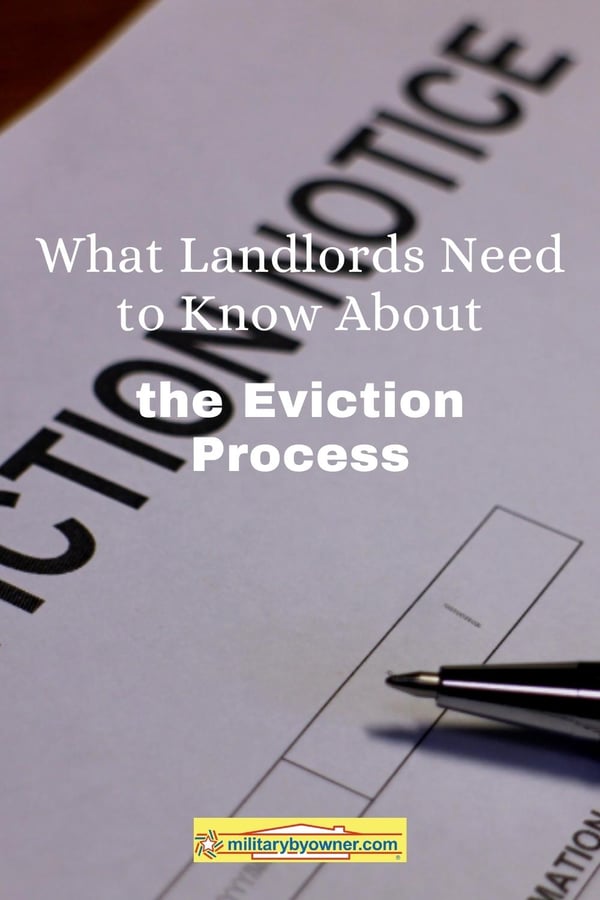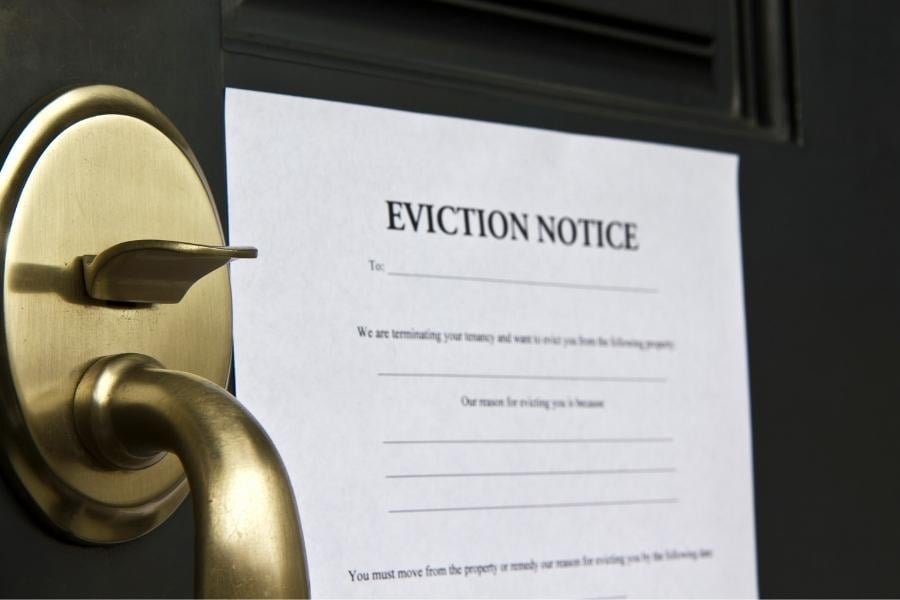What Landlords Need to Know About the Eviction Process
If you're a landlord and you're struggling with late rent, noise, cleanliness, pets behaving badly, pest infestations, criminal activity, or other neighbor complaints, and discover that your tenant will not correct their violations, or worse, will not leave, you may need to evaluate legal options for resolution and to preserve your property.
There may be pro-bono or low-cost options for local mediation or arbitration in your city or county, or if you are using a property manager, they may be able to guide you through the eviction process. However, in egregious scenarios or in the event you are self-managing the property, you may need to consult legal counsel to proceed with the eviction process to ensure you comply with all legal obligations as a landlord.

An Overview of the Eviction Process
It’s important to first understand that the eviction process can involve several steps, depending on the nature and egregiousness of the violation, if it is a repeat violation, or if the tenant is given notice to correct the violation and refuses. An eviction cannot proceed until a Notice of Termination is given to end the tenancy. And landlords must have a reason, or cause, to give a termination notice.
Eviction proceedings vary by state law, and each state will outline strict procedures a landlord must follow to terminate a tenancy once a tenant violation occurs and has not been corrected. Once a Notice for Termination is issued, state law often dictates a tenant legally must be afforded an opportunity to correct the issue before a landlord can file for eviction.
Most states dictate which notices must be afforded time to correct, whereas other states or scenarios, depending on the severity of the violation, may enable a landlord to file for eviction immediately once a Notice for Termination is given. For example, a first offense for late rent will likely not be treated the same in state statutes as a repeat offender or for violations materially affecting health and safety or criminal activity.
Six states (Indiana, Massachusetts, Missouri, North Carolina, North Dakota, Pennsylvania) dictate that a landlord can terminate the tenancy with an unconditional quit notice, with no requirement or ability for a tenant to cure or correct the violation. Eviction proceedings and process must be followed to the letter, to avoid landlord liability and an avenue for a tenant countersuit for an illegal eviction.
Notices for Termination: There’s More Than One
Notices for Termination are not created equal, and again, can vary greatly on state law. The most common options for notices are as follows.
Notice to Pay Rent or Quit
Late rent is one of the most common reasons a Notice for Termination is given. Nearly all states dictate a set timeframe in which a tenant must be afforded the chance to cure a violation for non-payment of rent. That timeframe can be as short as 3 days, up to 30 days, or a reasonable period of time to remove themselves and property from the premises.
 Image from Canva
Image from Canva
Notice to Cure or Quit
A Notice to Cure or Quit, is frequently issued for repeated noise violations, unmitigated trash attracting pests, illegal parking, or consistently blocking driveways or mailboxes (interrupting mail service), nuisance pets (or unauthorized pets), or other complaints consistently affecting the quiet enjoyment of neighbors. In a Notice to Cure or Quit, a tenant is given a deadline to correct, or cure, the violation.
If a tenant "cures" or corrects the violation, the tenancy remains. If the tenant does not "cure" the violation by the specified deadline, the Notice to Quit, or vacate the premises, takes effect. Again, state law will establish the timeframe, if any, which must be offered to correct the violation.
Unconditional Quit
An Unconditional Quit Notice affords a tenant no ability to correct the lease violation, and thus must be carefully substantiated in order to avoid an illegal eviction claim. Unconditional quit notices are allowed for some repeat violations such as repeatedly failing to pay utilities resulting in service termination or other violations of significant magnitude, such as illegal drugs, weapons, prostitution on the premises, illegal gambling, assaults and domestic violence, child abuse or neglect, subletting without permission, or materially affecting the health and safety of the premises (or neighbors). Examples of the last point include pest infestations or illegally feeding wildlife and drawing potentially dangerous animals into a neighborhood, such as moose, bears, or alligators.
In addition, state law usually dictates how a Notice for Termination must be delivered. Some states will allow for electronic notices, others require certified mail, while others may require both notification by certified mail and a printed notice placed in prominent view on the premises. Research your state’s mandates for correctly delivering notice.
Note: For safety considerations, some landlords may wish to consider a legal or courier service to deliver a notice in states where physical delivery and acknowledgement are required, as a tenant may become hostile or combative when notified of an Unconditional Quit.
When the First Cure or Quit or Unconditional Deadline Expires
Once the deadline expires for a termination notice, a tenant hopefully has cured the violation or voluntarily vacated (quit) the premises. However, if the deadline expires, and the tenant refuses to leave (or cure the violation), a landlord must file a motion for eviction with their local court, to seek a formal eviction decree known as a Writ of Possession, or in some states, Writ of Eviction.
 Image from Canva
Image from Canva
Filing Eviction Proceedings with the Court
If a tenant refuses to correct the violation and refuses to leave the premises, a landlord must adhere to the full judicial process to seek an eviction. Often, tenants must be given a summons, opportunity, and timeframe to plead their case before the court. If the court rules in the landlord’s favor, a Writ of Possession (or Judgment of Possession) is decreed, that the plaintiff has a right to the property.
It is common for the decree to include a timeline in which the tenant must vacate the premises, such as an example of 72 hours. In the event 72 hours passes and the tenant refuses to vacate, a Writ of Execution will be issued. Some courts may issue Writs of Execution simultaneously with a Writ of Possession, whereas others will require an additional filing to seek and win a Writ of Execution.
Writ of Execution
A Writ of Possession simply means the plaintiff has a right to the property; but a Writ of Execution must be decreed to legally transfer the property back to the plaintiff and/or authorize the use of law enforcement to physically oust a tenant from the premises.
In some cases, a Writ of Restitution may also be awarded as a judgment from the debtor to the plaintiff (in cases of property damage or back rent). If eviction proceedings have necessitated the need for law enforcement to physically remove a tenant from the premises, it would be wise for a landlord to fully consider and appreciate any safety mitigations offered from law enforcement. In rare situations, a tenant may become extremely combative, hostile, attack law enforcement, or initiate a hostage situation.
Be Mindful of Abandoned Possessions
Whether a tenant moves out voluntarily or is forced out following an eviction, landlords are often faced with clean up, repairs, and a unit full of abandoned personal property. Property that is clearly trash, such as old food, broken furniture, or cleaning supplies can be treated as such and immediately disposed of. Other abandoned belongings of any value, such as intact furniture, dishes, clothes and linens, bicycles, an inoperable vehicle, or electronics are another story. Again, state law dictates a landlord’s responsibility in storing and disposing personal, abandoned property, or selling the property.
 Photo by Jason Leung on Unsplash
Photo by Jason Leung on Unsplash
In many states, a landlord’s options for disposing or selling abandoned property depends upon the circumstances of a tenant’s departure, and may require the landlord to notify the tenant (or make an effort to locate and notify a tenant’s family members) that the abandoned property must be retrieved by a specific date or be forfeited. Some states allow greater landlord flexibility in disposing of abandoned belongings. Research your specific state law regarding any abandoned property restrictions before calling the 1-800-Got-Junk truck.
A Warning Regarding “Self-Help” Evictions
The eviction process can be expensive, time-consuming, and for most landlords, emotionally exhausting. As tempting as it may be to speed up the process and help boot a bad tenant to the curb, don’t. States and many local jurisdictions are quite strict about both landlord and tenant adherence to the defined eviction process. There is zero tolerance for landlord intimidation, harassment, bullying, threats, or violence to encourage or outright force a tenant to quit the premises without a court-granted eviction.
Examples of “self-help” evictions you should avoid:
- Removal of entry doors or windows
- Cutting off water, power, heat, or air conditioning
- Removing cooking facilities
- Threats, intimidation, or violence of any kind
- Harassment or bullying, such as entering the unit without a 24-Hour Notice of Entry for a non-emergency event (i.e. daily inspections to determine if tenant has cured a violation, or calling a tenant on the hour or in the middle of the night persistently to demand action)
Any landlord activity that falls in the realm of a “self-help” eviction opens a landlord to possible legal and financial liability and recourse, from the very tenant they are attempting to evict.
Owning rental property can offer significant wealth-building opportunities, but as with all investments, there is risk, to include encountering an eviction scenario. But not to worry, the experts at MilitaryByOwner are here to help with each step of your military housing journey, bad tenants, and horror stories included. Learn more: Property Management Resources.
Are you a military landlord? Download our free resource below, designed to walk you through each step of managing your own rental property.

.jpg)



